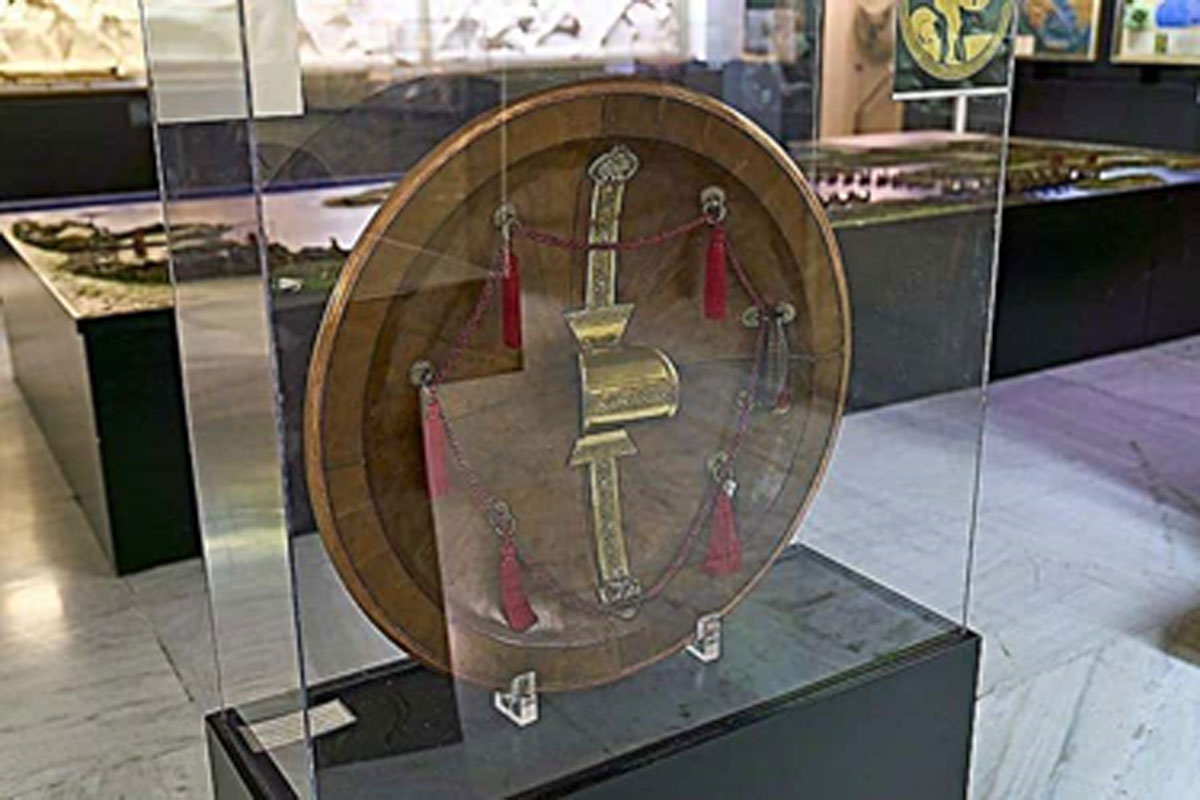
How Heavy Historical Weapons And Armor Actually Were
Emily Mast
We’ve all seen paintings of knights – in their shiny armor on top of their majestic steeds. But have you ever wondered just how much all that metal weighed?
Did the knights’ heads hurt from holding up those heavy helmets? What about the lances? How heavy were those 10-foot-plus poles?
Throughout time, different weapons served different purposes; weapons used in close, hand-to-hand combat needed to be light and easy to maneuver. However, calvary knights could afford to wield heavier objects that could plow over whoever got in their way.
But looks can be deceiving regarding weapons of old. Sometimes a weapon that was more than a foot long weighed less than a pound. Other times, a seemingly simple weapon may weigh far more than we expect.
Which weapon would you want to take into battle? And which do you think just isn’t worth its weight?
________________________________________
• Photo: George E. Koronaios / Wikimedia Commons / CC-BY-SA 4.0
1
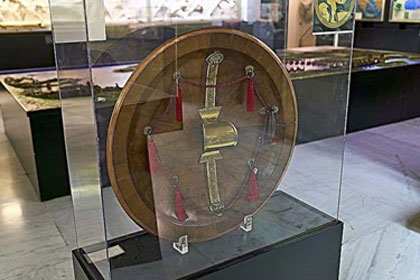 Aspis (Greece) C.600s BCE – 18 Pounds
Aspis (Greece) C.600s BCE – 18 Pounds
When a commoner was called to fight for the ancient Greeks, they were expected to bring their own equipment. So the better you made your armor, the better chance you had at surviving.
One of the most important pieces of equipment was the aspis, or what we’d call today a shield. The aspis was about one meter in diameter and was made of wood and sometimes covered with bronze (depending on what the user could afford).
While the aspis did do a good job of protecting the soldier against arrows and swords, one had to be quite strong to carry it, as the shield could weigh up to 18 pounds.
While this may not seem too bad for some of you, remember that this was being carried by only one arm, while the soldier was using his other to fight.
What do you think?
Worth it?
• • Photo: Yale University Art Gallery / Wikimedia Commons / Public domain
2
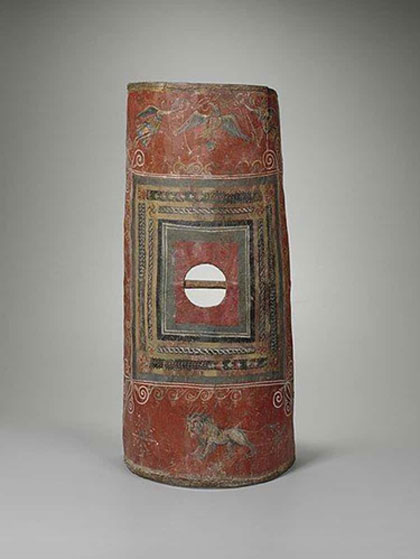 Scutum (Rome) C. 200s – Up To 22 Pounds
Scutum (Rome) C. 200s – Up To 22 Pounds
While we may think a piece of equipment called “scutum” protected a sensitive part of the body, it actually protected the torso and chest.
The scutum was the ancient Roman’s version of the shield, and it was slightly bent so that assailant’s arrows were more likely to bounce off or slide down the scutum’s surface.
The scutum was made of two thin boards stuck together with beef glue. Then the exterior was wrapped in cloth and leather, and was reinforced with a protruding knob in the center of the shield, called a navel, made from bronze or iron. All of this added up to the scutum weighing a whopping 22 pounds.
Over the years, the scutum went through various transformations. At first, it was oval. Over time, it became smaller and more rectangular, likely to make it easier to handle for soldiers.
Worth it?
• • Photo: Metropolitan Museum of Art / Wikimedia Commons / CC0
3
 War Hammer (Europe) C.1200s – 2-5 Pounds
War Hammer (Europe) C.1200s – 2-5 Pounds
Fans of Norse mythology (and Marvel) are familiar with Mjolnir, the war hammer of Thor. War hammers were quite popular for several centuries, starting in the 1200s.
And the common war hammer was, of course, much lighter than the immovable Mjolnir – clocking in at between two and five pounds.
While Mjolnir was a more blunted, traditional hammer, many war hammers had a sharp blade on one end. This allowed soldiers flexibility; they could use the flat end for sheer force, like knocking a foe off a horse. Then, they could use the sharp end to puncture armor.
Because of the wide range of uses, the war hammer was used by both knights and lowly foot soldiers. Those from upper ranks would have more intricate, detailed hammers, while the lower class would use whatever metal they could get their hands on.
Worth it?
• • Photo: Unknown / The Cleveland Museum of Art / CC0
4
 Corinthian Helmet (Greece) C. 400s BCE – 5 Pounds
Corinthian Helmet (Greece) C. 400s BCE – 5 Pounds
The human neck can sure support a lot of weight. The average adult head, for example, weighs 11 pounds. But anything added on after those 11 pounds can begin to put quite the strain on our spinal cords. This is why the average bicycle helmet today only weighs between 10 and 12 ounces.
Going back a few hundred years, metal helmets designed for battle weighed roughly three pounds. This offered protection, while allowing the helmets to be somewhat comfortable.
Let’s look back, then, to the ancient Greeks, who said, “Screw it!” to neck pain. A Corinthian helmet was found that was made of bronze and silver inlay; and weighed a whopping five pounds.
Our condolences to the unlucky soldier who had to wear that into battle.
Worth it?
• • Photo: Tropenmuseum, part of the National Museum of World Cultures / Wikimedia Commons / CC-BY-SA 3.0
5
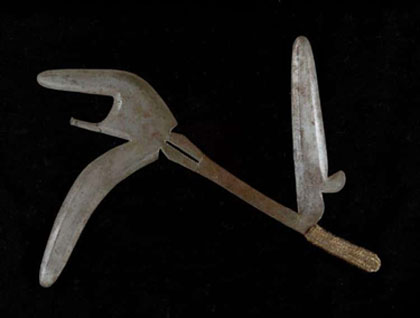 Kpinga (Africa) C. 1800s – 0.5 Pounds
Kpinga (Africa) C. 1800s – 0.5 Pounds
Cultures from all over the world have relied on small, aerodynamic blades to inflict pain on their opponents.
Originally made in Egypt, the kpinga was a highly coveted weapon. It could be quite large – a foot long – and would have multiple blades that were all razor sharp.
Because it took a great deal of skill to properly make a kpinga, only the best soldiers were awarded a kpinga by their ruler. The weapon was so revered that it could actually be used in place of a dowry.
As the weapon was meant to be thrown, it couldn’t be very heavy. So the kpinga weighed in at approximately half a pound, despite being over a foot long.
• Worth it?
• • Photo: Thomas Quine / Flickr / CC-BY 2.0
6
 Zweihander (Germany) C. 1400s – 10 Pounds
Zweihander (Germany) C. 1400s – 10 Pounds
If you’re familiar with the German language, you might recognize the first part of this weapon, “zwei” as meaning “two.” That’s because this behemoth of a sword required soldiers to use two hands to wield it.
Typical swords in 15th century Europe weighed between three to seven pounds; however, the zweihander weighed upwards of 10 to even 15 pounds. This was due in large part to their enormous length: the blades alone could be almost four feet long.
So who wielded these massive weapons? The landsknechte, a highly-skilled group of soldiers who were eventually hired as mercenaries for their elite skill set (meaning landsknechte could be fighting on both sides of the battlefield).
The zweihander was not designed for stabbing its victims but rather hacking through the pike formations of the enemy. This meant that the tips of the blades were actually sometimes blunt.
Worth it?
• • Photo: Unknown / Metropolitan Museum of Art / Public domain
7
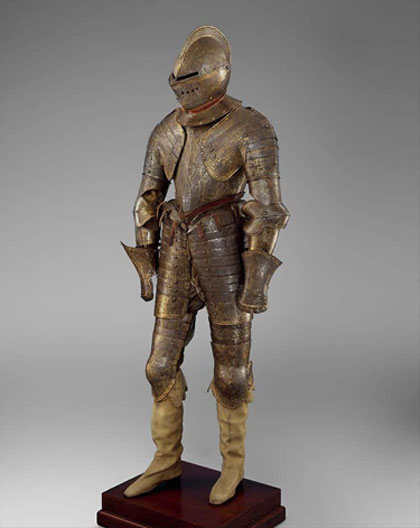 Heavy Cavalry Armor (France) C.1600s – 77 Pounds
Heavy Cavalry Armor (France) C.1600s – 77 Pounds
Many of us have wondered just how medieval knights got around in those heavy suits of armor. It must have been hard to walk, let alone fight, with pounds of metal around you.
So how heavy were these suits of armor? Twenty? Thirty pounds?
Try almost eighty. Yes, in 17th century France, these knights were carrying around the weight equivalent of an 11-year-old child on their bodies. Even more, these were the calvary knights, meaning they had to lug that gilded armor up onto horses to charge into battle.
The thickness of the armor, and following weight, was due to the introduction of firearms in battle; meaning the knights needed to be even more heavily protected than they were from lances.
Worth it?
• • Photo: Metropolitan Museum of Art / Wikimedia Commons / CC0
8
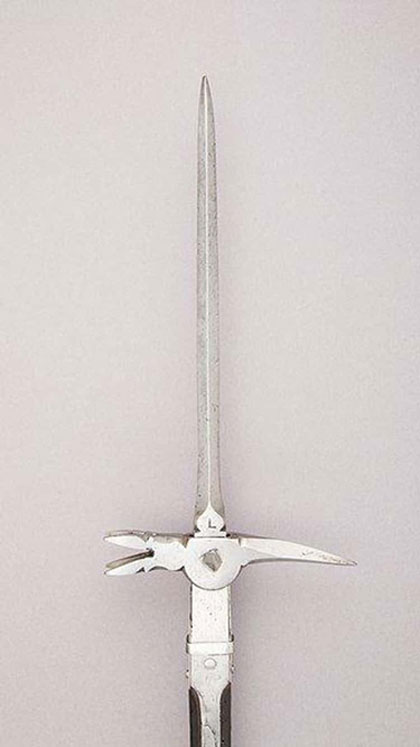 Lucerne Hammer (Switzerland) C.1400s – 5-13 Pounds
Lucerne Hammer (Switzerland) C.1400s – 5-13 Pounds
In 15th century Switzerland, the war hammer wasn’t quite terrifying enough for the Swiss. They wanted to take the weapon one step further. So, they added a long pointy blade on the top.
Lucerne hammers also had a longer shaft than war hammers, meaning they could jab their opponents with the top blade from rather far away.
However, this additional length also added to the overall weight of the weapon. Smaller Lucerne hammers could weight about five pounds, with larger ones weighing all the way up to 13 pounds (which would be about the same weight as a bowling ball).
For ceremonial purposes, such as a parade, special Lucerne hammers could be made – some of them weighing as much as 31 pounds.
Worth it?
• • Photo: Metropolitan Museum of Art / Wikimedia Commons / CC0
9
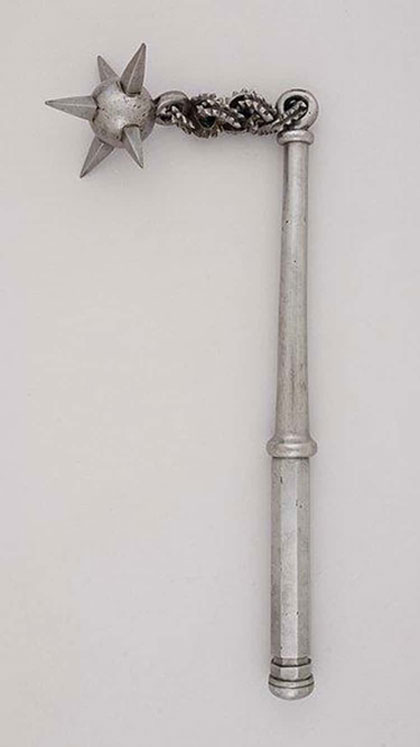 Flail (Europe) C. 1300s – 5 Pounds
Flail (Europe) C. 1300s – 5 Pounds
Many of us are familiar with the flail. The spiked ball on a chain often pops up in medieval movies – often with a ginormous, extra menacing knight wielding one.
The flail wasn’t originally created for violent purposes. It initially was made for agriculture, to help remove the corn from the stalks. However, people quickly realized its potential for war, and it was adapted accordingly.
Since flails were mostly used for hand-to-hand combat, knights and soldiers didn’t want the ball too heavy; if it was, it would take more time for the fighter to readjust if their first strike wasn’t fatal.
This meant that the flail weighed only about five pounds.
Worth it?
• • Photo: Paulus Hector Mair / Wikimedia Commons / Public domain
10
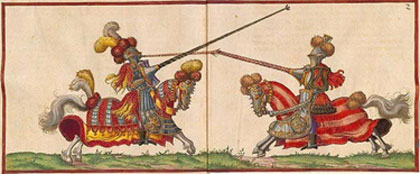 Lance (Europe) C. 1500s – 15 Pounds
Lance (Europe) C. 1500s – 15 Pounds
When some of us hear “lance,” we think of the long pole that knights used to knock their opponents off their horses in jousting tournaments. This is a type of lance known as a “heavy lance”; these lances could be 10 feet long and weigh up to 15 pounds. Since the purpose of these lances was to knock a rider off (without impaling him) the lance had a flat end.
However, lances have been around since the 4th century, when Byzantine armies used them on horseback. These lances often had a sharp point on the end of them, allowing riders to inflict damage from a distance.
The lances, known as “light lances,” could be thrown much like spears, and were shorter and lighter than their later jousting counterparts.
Worth it?
• • Photo: Alf van Beem / Wikimedia Commons / CC0
11
 Morning Star (Germany) c. 1300s – 2-12 Pounds
Morning Star (Germany) c. 1300s – 2-12 Pounds
“Morning star” is such a delicate name for a brutal weapon. The morning star was essentially a staff with a dense ball on the end with spikes on it.
Morning stars were not one-size-fits-all. They had different shapes and sizes for different soldiers. Foot soldiers, dealing in hand-to-hand combat, might have the lighter version of the morning star, which weighed as little as two pounds. The sharp spikes on the ball allowed the weapon to puncture, as well as bludgeon, a knight’s adversaries.
However, for knights on horses, they’d want something with a bit more heft to it, as they also used the weapon to attack their opponents’ horses. These morning stars might have a shorter staff, for better control, with a heavy ball on the end.
Sometimes, these weapons weighed up to 12 pounds (which is about the equivalent of swinging around a can of paint).
Worth it?
• • Photo: Unknown / Metropolitan Museum of Art / Public domain
12
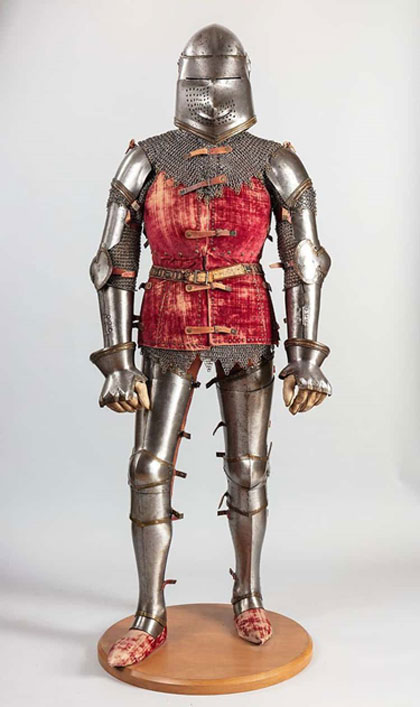 Infantry Armor (Italy) C.1400s – 41 Pounds
Infantry Armor (Italy) C.1400s – 41 Pounds
At least 15th century Italian infantrymen didn’t have it quite as tough as the French calvary knights. A few centuries earlier, the armor didn’t need to protect against gunfire, so it didn’t need to be quite as heavy. For that reason, this suit weighs in at 41 pounds.
What made this suit of armor unique was the brigandine, a defensive piece that sat atop the torso and consisted of multiple overlapping plates. This armor was made out of steel and copper alloy, and also had pieces of leather and velvet atop it.
Worth it?

















